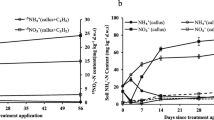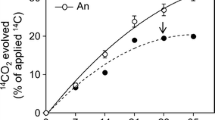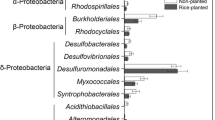Abstract
Purpose
Plant residues are one of the main sources of soil organic matter in paddy fields, and elucidation of the bacterial communities decomposing plant residues was important to understand their function and roles, as the microbial decomposition of plant residues is linked to soil fertility. We conducted a DNA stable isotope probing (SIP) experiment to elucidate the bacterial community assimilating 13-carbon (13C) derived from plant residue under an anoxic soil condition. In addition, we compared the bacterial community with that under the oxic soil condition, which was elucidated in our previous study (Lee et al. in Soil Biol Biochem 43:814–822, 2011).
Materials and methods
We used the 13C-labeled dried rice callus cells as a model of rice plant residue. A paddy field soil was incubated with unlabeled and 13C-labeled callus cells. DNA extracted from the soils was subjected to buoyant density gradient centrifugation to fractionate 13C-enriched DNA. Then, polymerase chain reaction (PCR) and denaturing gradient gel electrophoresis (DGGE) analysis of bacterial 16S rDNA band patterns and band sequencing method were used to evaluate bacterial community.
Results and discussion
DGGE analysis showed that the band patterns in the 13C-enriched fractions were distinctly changed over time, while the changes in the community structure before fractionation were minor. Sequencing of the 13C-labeled DGGE bands revealed that Clostridia were a major group in the bacterial communities incorporating the callus-derived carbon although Gram-negative bacteria, and Actinobacteria also participated in the carbon flow from the callus under the anoxic condition. The proportion of Gram-negative bacteria and Actinobacteria increased on 14 days after the onset of incubation, suggesting that the callus was decomposed by diverse bacterial members on this phase. When the bacterial groups incorporating the 13C were compared between under anoxic and oxic soil conditions, the composition was largely different under the two opposite conditions. However, some members of Gram-negative bacteria were commonly found under the anoxic and oxic soil conditions.
Conclusions
The majority of bacterial members assimilating the callus carbon was Clostridia in the soil under anoxic conditions. However, several Gram-negative bacterial members, such as Acidobacteria, Bacteroidetes, and Proteobacteria, also participated in the decomposition of callus under anoxic soil conditions. Our study showed that carbon flow into the diverse bacterial members during the callus decomposition and the distinctiveness of the bacterial communities was formed under the anoxic and oxic soil conditions.




Similar content being viewed by others
References
Cahyani VR, Matsuya K, Asakawa S, Kimura M (2003) Succession and phylogenetic composition of bacterial communities responsible for the composting process of rice straw estimated by PCR-DGGE analysis. Soil Sci Plant Nutr 49:619–630
Cahyani VR, Matsuya K, Asakawa S, Kimura M (2004) Succession and phylogenetic profile of eukaryotic communities in the composting process of rice straw estimated by PCR-DGGE analysis. Biol Fertil Soils 40:334–344
Chu CC, Wang CC, Sun CS, Hsu C, Yin KC, Chu CY, Bi FY (1975) Establishment of an efficient medium for anther culture of rice through comparative experiments on the nitrogen sources. Sci Chin 18:659–668
Jackson CR, Harper JP, Willoughby D, Roden EE, Churchill PF (1997) A simple, efficient method for the separation of humic substances and DNA from environmental samples. Appl Environ Microbiol 63:4993–4995
Kimura M, Murase J, Lu Y (2004) Carbon cycling in rice field ecosystems in the context of input, decomposition and translocation of organic materials and the fates of their end products (CO2 and CH4). Soil Biol Biochem 36:1399–1416
Kumada K, Asami M (1958) A new method for determining ferrous iron in paddy soils. Soil Plant Food 3:187–193
Lee CG, Watanabe T, Sato Y, Murase J, Asakawa S, Kimura M (2011) Bacterial populations assimilating carbon from 13C-labeled plant residue in soil: analysis by a DNA-SIP approach. Soil Biol Biochem 43:814–822
Lu Y, Murase J, Watanabe A, Sugimoto A, Kimura M (2004) Linking microbial community dynamics to rhizosphere carbon flow in a wetland rice soil. FEMS Microbiol Ecol 48:179–186
Lueders T, Pommerenke B, Friedrich MW (2004) Stable-isotope probing of microorganisms thriving at thermodynamic limits: syntrophic propionate oxidation in flooded soil. Appl Environ Microbiol 70:5778–5786
Manefield M, Whiteley AS, Griffiths RI, Bailey MJ (2002) RNA stable isotope probing, a novel means of linking microbial community function to phylogeny. Appl Environ Microbiol 68:5367–5373
Murase J, Matsui Y, Katoh M, Sugimoto A, Kimura M (2006) Incorporation of 13C-labeled rice-straw-derived carbon into microbial communities in submerged rice field soil and percolating water. Soil Biol Biochem 38:3483–3491
Muyzer G, Waal ECD, Uitterlinden AG (1993) Profiling of complex microbial populations by denaturing gradient gel electrophoresis analysis of polymerase chain reaction-amplified genes coding for 16S rRNA. Appl Environ Microbiol 59:695–700
Nakamura A, Tun CC, Asakawa S, Kimura M (2003) Microbial community responsible for the decomposition of rice straw in a paddy field: estimation by phospholipid fatty acid analysis. Biol Fertil Soils 38:288–295
Oksanen J, Blanchet FG, Kindt R, Legendre P, O’Hara RB, Simpson GL, Solymos P, Henry M, Stevens H, Wagner H (2007) Vegan: community ecology package. R package, version 1.17–2. http://CRAN.R-project.org/ package = vegan
Radajewski S, Ineson P, Parekh NR, Murrell JC (2000) Stable-isotope probing as a tool in microbial ecology. Nature 403:646–649
Rainey FA (2001) Family X. Veillonellaceae. In: Garrity GM, Jones D, Krieg NR, Laudwig W, Rainey FA, Schleifer K-H, Vos P, Whitman WB (eds) Bergey’s manual of systematic bacteriology, Second edn. Volume Three, Springer, New York, pp. 1059–1129
Rolfe R, Meselson M (1959) The relative homogeneity of microbial DNA. Proc Natl Acad Sci U S A 45:1039–1043
Rui J, Peng J, Lu Y (2009) Succession of bacterial populations during plant residue decomposition in rice field soil. Appl Environ Microbiol 75:4879–4886
Schellenberger S, Kolb S, Drake HL (2010) Metabolic responses of novel cellulolytic and saccharolytic agricultural soil bacteria to oxygen. Environ Microbiol 12:845–861
Shrestha M, Shrestha PM, Conrad R (2011) Bacterial and archaeal communities involved in the in situ degradation of 13C-labelled straw in the rice rhizosphere. Environ Microbiol Rep 3:587–596
Sugano A, Tsuchimoto H, Tun CC, Asakawa S, Kimura M (2005) Succession and phylogenetic profile of eubacterial communities in rice straw incorporated into a rice field: estimation by PCR-DGGE analysis. Soil Sci Plant Nutr 51:51–60
Thrash JC, Coates JD (2011) Phylum XVII. Acidobacteria phyl. Nov. In: Krieg NR, Staley JT, Brown DR, Hedlund BP, Paster BJ, Ward NJ, Ludwig W, Whitman BW (eds) Bergey’s manual of systematic bacteriology, Second edn. Volume Four, Springer, New York, pp. 725–735
Toki S (1997) Rapid and efficient agrobacterium-mediated transformation in rice. Plant Mol Biol Rep 15:16–21
Waksman SA, Stevens KR (1930) A critical study of the methods for determining the nature and abundance of soil organic matter. Soil Sci 30:97–116
Watanabe A, Katoh K, Kimura M (1993) Effect of rice straw application on CH4 emission from paddy fields. II. Contribution of organic constituents in rice straw. Soil Sci Plant Nutr 39:707–712
Weber S, Stubner S, Conrad R (2001) Bacterial populations colonizing and degrading rice straw in anoxic paddy soil. Appl Environ Microbiol 67:1318–1327
Acknowledgements
We thank Professors Makoto Kimura and Akira Watanabe and Associate Professor Jun Murase, Graduate School of Bioagricultural Sciences, Nagoya University, for their valuable criticisms, comments, and suggestions. We also thank Dr. Yutaka Sato, Graduate School of Bioagricultural Sciences, Nagoya University, for preparing callus cells. We wish to thank the members of Aichi-ken Anjo Research and Extension Center for allowing us to use the soil samples.
Author information
Authors and Affiliations
Corresponding author
Additional information
Responsible editor: Jizheng He
Rights and permissions
About this article
Cite this article
Lee, C.G., Watanabe, T. & Asakawa, S. Bacterial community incorporating carbon derived from plant residue in an anoxic non-rhizosphere soil estimated by DNA-SIP analysis. J Soils Sediments 17, 1084–1091 (2017). https://doi.org/10.1007/s11368-016-1621-0
Received:
Accepted:
Published:
Issue Date:
DOI: https://doi.org/10.1007/s11368-016-1621-0




